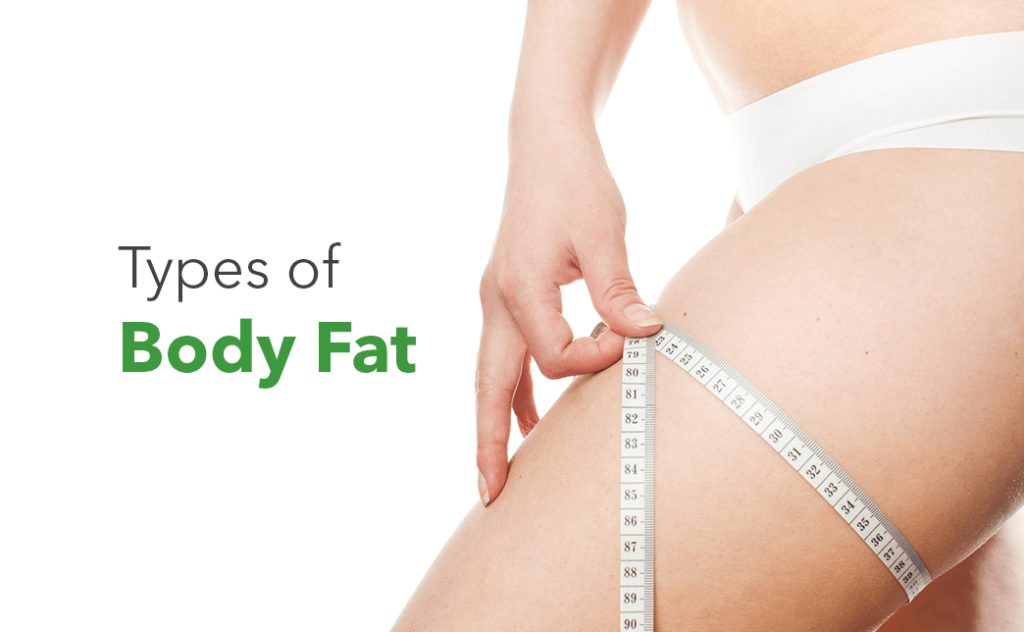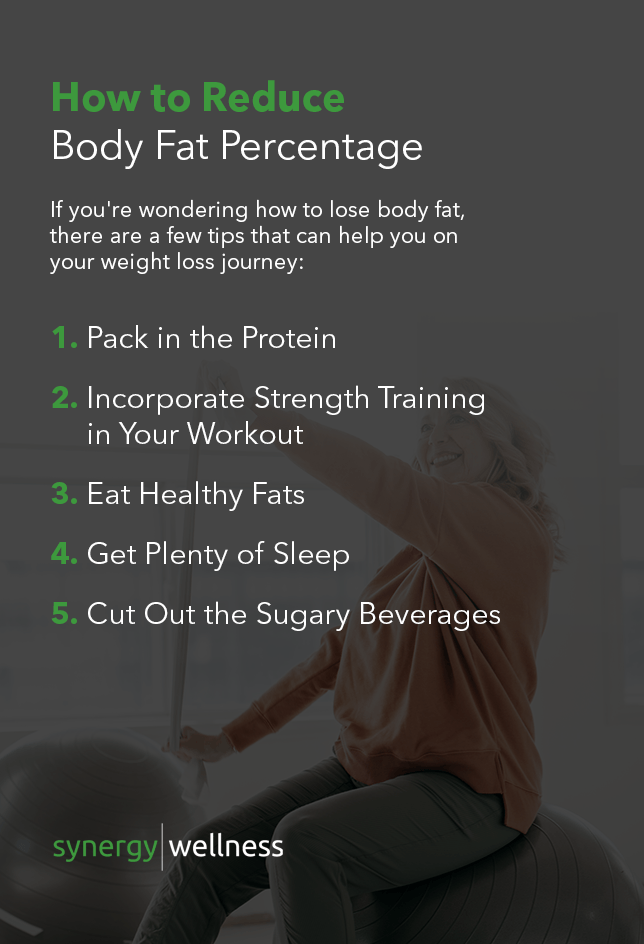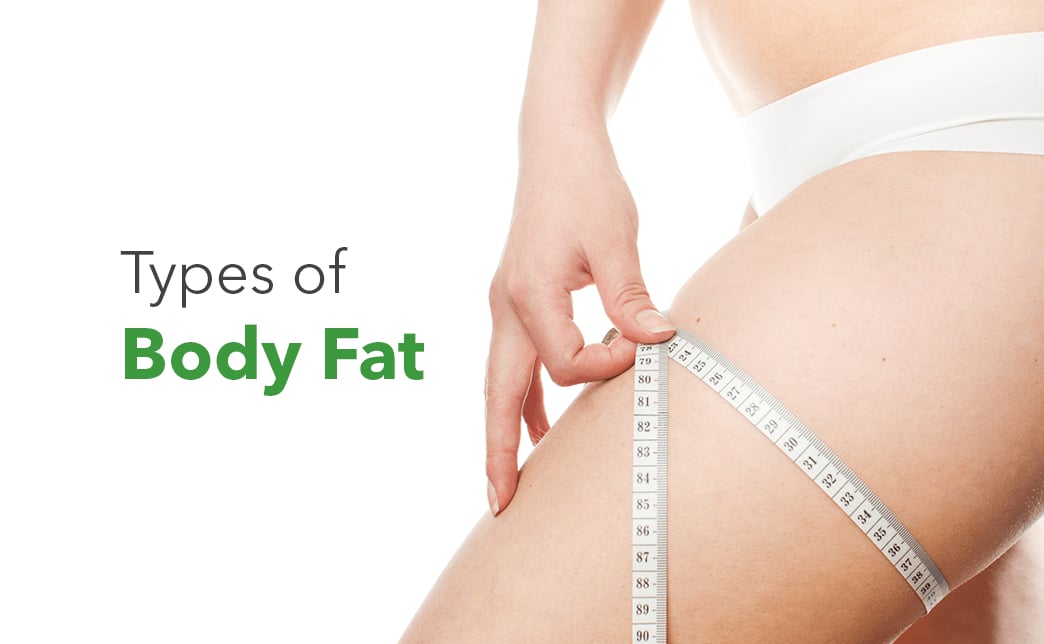
Everyone needs body fat to survive. The human body relies on stores of fat to provide energy each day. Fat can also help keep the body warm or cushion certain internal organs. The right kind of fat is a good thing for your body. But if your body doesn’t have the right balance of fat types, you may be at risk for a number of serious health issues.

What Is Body Fat?
Scientifically referred to as “adipocytes” or “adipose tissue,” body fat is the term used to describe fat cells that reside inside the human body. The primary purpose of these cells is to store energy — which comes from nutrients in food — until the body needs it. Its secondary purpose is to insulate the body. Although most body fat is found beneath the skin, certain types of fat can also be found around internal organs where it provides protection.
Some people mistakenly believe that a person’s weight determines whether or not they are obese. Obesity is actually determined by the amount of body fat a person houses inside their body. A man or woman with high levels of body fat is considered obese.
Types of Fat
The human body produces four types of fat, and each has different properties and purposes:
1. Visceral Fat
Visceral fat is the hard fat that is found wrapped around organs in the abdominal cavity. It can sometimes also be called “deep fat.” People with higher levels of visceral fat typically consume a diet high in refined carbohydrates, alcohol, trans fats and saturated fats. The more of these foods a person consumes, the more visceral fat their body may store in the abdominal cavity.
High levels of visceral fat can lead to a higher risk of many health issues, including cancer, stroke, heart attack, dementia and high metabolic syndrome. It can also interfere with insulin production, increasing the risk of diabetes. A 2014 study even found that individuals with higher visceral fat levels showed higher levels of calcification inside their coronary arteries.
2. Subcutaneous Fat
Also known as a “soft fat,” subcutaneous fat is the fat that is typically used to measure a person’s body mass index (BMI). Given its location under the skin and outside of the abdominal cavity, this is often the fat we see around the waist, thighs, hips and buttocks when we look in the mirror.
Unlike visceral fat, subcutaneous fat can actually provide some health benefits, according to a 2015 study published in Cardiovascular Diabetology. The study found that a buildup of this soft fat directly corresponded with a decreased risk of buildup of cholesterol and fat inside artery walls. This type of fat is also associated with a decreased risk of calcium buildup inside the coronary artery.
That’s not to say that people should intentionally build up more subcutaneous fat. Having too much of this type of fat can put a strain on ligaments and tendons because it adds body weight.
3. Brown Fat
Brown fat is found in humans of all ages, but it’s typically found in larger concentrations in infants. This is because brown fat’s purpose in the body is to burn the energy it has stored in order to generate heat. Infants need the added warmth and protection of more brown fat than adults do.
Brown fat tends to be subcutaneous because most of it is found around the shoulder blades, spine and the collarbone. However, it can be found around some organs, so it does have the potential to be more visceral. Its connection to potential health risks or benefits is not widely known.
4. White Fat
The human body relies on white fat to store nutrients and energy for use when it needs it. Most of the fat in the body can be classified as white fat. This function does not necessarily mean that brown fat wins in the brown fat vs. white fat comparison.
The human body needs healthy levels of both to operate as it should. White fat can be either visceral or subcutaneous, depending on where it’s located. This means that some white fat can be beneficial, while other white fat may be considered visceral and put an individual at higher risk for a variety of health issues.

How Is Fat Stored in the Body?
The human body stores fat in two different ways. Essential fat is the fat that is found in the muscles, central nervous system and even bone marrow. Its purpose is to fuel the day-to-day functioning of the body. Stored fat is the fat that can be found under our skin and around our organs.
Where do fat cells come from? The human body is born with fat cells that process and distribute the nutrients and energy you consume when you eat. If a person is eating a healthy, balanced diet, the fat cells will process the nutrients and distribute them throughout the body to provide energy.
If a person is consuming excessive sugar, saturated fats and other processed foods, the fat cells will process them and they will be stored around the body as unhealthy fat. A healthy diet encourages fat cells to absorb and process nutrients efficiently and convert those nutrients to the energy the body needs each day. An unhealthy diet encourages fat cells to store more fat, cultivating a buildup of unhealthy fat inside of the body.
What Is a Healthy Body Fat Percentage?
The word “fat” has been misrepresented throughout our society as the enemy of good health and nutrition. But the truth is that the human body needs fat. Fat helps process nutrients in the food we eat and it even helps keep us warm. But how much fat is the right amount?
In the past, BMI has often been used as an indicator of the fat levels inside the human body. But measuring someone’s BMI doesn’t measure their actual body fat percentage. The best way to measure body fat percentage is with an MRI or CT scan, but these tests are too expensive and invasive to prescribe just for this purpose. A person’s body fat percentage is typically derived from an equation that takes age, weight, gender and height into account. There are even online calculators that input information into a formula to estimate body fat percentage.
A healthy body fat percentage depends on several factors, and it isn’t the same for each person. Instead, ranges have been established for how men and women at various ages and levels of fitness should be measured.
There is still a significant correlation between body fat percentage and BMI. Since you can’t see body fat, taking BMI measurements using calipers is a good way to get an idea of what’s going on inside the human body. The best way to ensure the most accurate results is to have this done by a healthcare professional.
Though BMI can often be an indicator of body fat percentage, it’s important to remember the following:
- Women naturally have a higher body fat percentage than men, even if they have the same BMI.
- Older adults naturally have a higher body fat percentage than younger adults, even if they have the same BMI.
- Athletes tend to have lower body fat percentages than non-athletes
- Individuals of certain ethnic backgrounds naturally have varying levels of healthy body fat.
Why Do Men and Women Have Different Body Fat Percentages?
It’s true that men and women have different body fat percentages. But this doesn’t mean that one gender is fatter than the other. In fact, a woman and man can share the same BMI but have a different percent of body fat. So why the difference?
Science has found that a woman’s body doesn’t need as many calories of food as a man does each day because the female body doesn’t burn calories as quickly. Instead, the female body stores them because body fat aids the reproductive system.
Women who take hormonal birth control are also prone to a higher body fat percentage because estrogen — the primary hormone in many birth control options — causes the human body to produce more fat.

How to Reduce Body Fat Percentage
When used correctly, body fat percentage can be an effective measure of weight loss. On average, an adult can expect to lose between 1% and 3% of their body fat percentage each month on a healthy plan of diet and exercise. However, this range can vary, depending on age, gender, weight and hormones. If you’re wondering how to lose body fat, there are a few tips that can help you on your weight loss journey:
1. Pack in the Protein
A high-protein diet has been shown to burn fat while decreasing appetite. Studies have also found that consuming high-quality protein sources helps to reduce belly fat. Aim to consume protein-rich foods such as eggs, legumes, seafood, lean meats and dairy.
2. Incorporate Strength Training in Your Workout
Strength training — often called resistance training — is a great way to build muscle mass and reduce visceral fat. Many people associate strength training with bodybuilding, but that’s only one option. Bodyweight exercises are strength training exercises that can be done with minimal equipment and in the privacy of your own home.
If you’re wondering how to get rid of subcutaneous fat with exercise, combining strength training with regular cardiovascular exercise that gets your heart rate up is a great option. Walking, running or swimming are all excellent options for cardiovascular exercise.
Daily exercise is important, regardless of how old you are or how much you weigh. If you haven’t already been exercising on a regular basis, schedule a visit with your doctor to discuss the best way to ease into physical fitness. Doing too much too quickly can result in fatigue or injury — both of which can shortchange your weight loss goals.
3. Eat Healthy Fats
Eating the right kinds of fats can actually help you lose fat. Healthy fats aren’t necessarily low in calories, but the body digests them slower, so you feel full longer. Healthy fats include avocados, olive oil, coconut oil, seeds and nuts. Rather than eating this in addition to the rest of your diet, try making swaps. For example, instead of cooking with canola or vegetable oil, use olive oil. Or, add avocado to a salad instead of croutons and extra salad dressing.
One great way to ensure you’re getting the right fats in your diet is to follow the Mediterranean diet. The Mediterranean diet relies heavily on healthy fats in foods and has been associated with healthier weight levels in adults. In addition to incorporating healthy fats into your diet, avoid processed foods and carbohydrates and increase your fiber consumption.
4. Get Plenty of Sleep
Getting the right amount of sleep each night is important to encourage weight loss. Lack of sleep has been shown to stimulate appetite and alter the hormones that influence our hunger. Although each adult may have different sleep needs, it’s good to aim for seven hours each night for optimal weight loss.
5. Cut Out the Sugary Beverages
Although they taste good, sodas, juices and alcohol are packed with unhealthy sugars that stimulate fat production in the body and impede weight loss. Swapping out these sweet treats for water or green tea can reduce your consumption of “empty” calories. Drinking water before meals has also been shown to reduce appetite, meaning you’re less likely to overeat if you’ve had a glass of water first.
Coffee isn’t considered a sugary drink because it does have some basic health benefits on its own. Skip the sugar-laden creamers and stick to black coffee or coffee with just a splash of milk if you’re looking to reduce your body fat percentage

Lose Weight With Synergy Wellness Center
Many people think they know how to reduce body fat, but even with all the “right” steps, weight loss still may not happen. At Synergy Wellness Center, our medical weight loss programs are tailored to meet your individual needs. Designed with the highest degree of professionalism and confidence, our Bakersfield, California-based center can offer the tools and support you need to get healthy.
If you are interested in learning more about your health or weight loss, call Synergy Wellness Center today to speak to one of our staff members.



